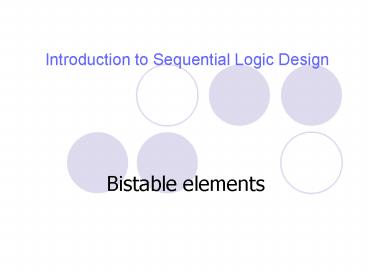Introduction to Sequential Logic Design - PowerPoint PPT Presentation
1 / 15
Title:
Introduction to Sequential Logic Design
Description:
Clock is active low: falling edge, or when LOW ... Clocked synchronous state machine: uses above building blocks to create circuit. 6 ... – PowerPoint PPT presentation
Number of Views:51
Avg rating:3.0/5.0
Title: Introduction to Sequential Logic Design
1
Introduction to Sequential Logic Design
Bistable elements
2
Sequential Systems
- A combinational system is a system whose outputs
depends only upon its current inputs. - A sequential system is a system whose output
depends on current input and past history of
inputs. - All systems we have looked at to date have been
combinational systems.
3
Sequential Circuits
- Outputs depends on the current inputs and the
systems current state. - State embodies all the information about the
past needed to predict current output based on
current input. - State variables, one or more bits of information.
The state is a collection of state variables
whose values at any one time contain all the
information about the past necessary to account
for the circuits future behavior. Herbert
Hellerman, Digital Computer Systems Principles
4
Describing Sequential Circuits
- State table
- For each current-state, specify next-states as
function of inputs - For each current-state, specify outputs as
function of inputs - State diagram
- Graphical version of state table
- More on this next week
5
Finite State Machine
- A circuit with n binary state variables has 2n
possible states, which is always finite, so
sequential circuits are sometimes called
Finite-State Machines (FSM). - For most sequential circuits, the state changes
occur at times specified by a free-running clock
signal. - Clock is active high state changes occur ar
rising edge, or when the clock is HIGH - Clock is active low falling edge, or when LOW
- Feedback sequential circuit uses ordinary gates
and feedback loops to obtain memory, create build
blocks - Clocked synchronous state machine uses above
building blocks to create circuit.
6
Clock signals
- Very important with most sequential circuits
- State variables change state at clock edge.
7
Bistable element
- The simplest sequential circuit, no way to
control its state. - Two states
- One state variable, say, Q, two possible states
8
Analog analysis
- Assume pure CMOS thresholds, 5V rail
- Theoretical threshold center is 2.5 V
2.5 V
2.5 V
2.51 V
5.0 V
0.0 V
2.5 V
2.5 V
4.8 V
0.0 V
5.0 V
9
Metastability
- Metastability is inherent in any bistable circuit
- Two stable points, one metastable point
10
Another look at Metastability
11
Why all the harping on metastability?
- All real systems are subject to it
- Problems are caused by asynchronous inputs that
do not meet flip-flop setup and hold times. - Details in Chapter-7 flip-flop descriptions and
in Section 8.9 (later in course ECE4110). - Especially severe in high-speed systems
- since clock periods are so short, metastability
resolution time can be longer than one clock
period. - Many digital designers, products, and companies
have been burned by this phenomenon.
12
Back to the bistable.
- How to control it?
- Control inputs
13
Back to the bistable.
- How to control it?
- Control inputs
- S-R latch
14
Terminology
- A bistable memory device is the generic term for
the elements we are studying. - Latches and flip-flops (FFs) are the basic
building blocks of sequential circuits. - latch bistable memory device with level
sensitive triggering (no clock), watches all of
its inputs continuously and changes its outputs
at any time, independent of a clocking signal. - flip-flop bistable memory device with
edge-triggering (with clock), samples its inputs,
and changes its output only at times determined
by a clocking signal. - Warning some authors use the terminology
Flip-Flop and Clocked Flip-Flop instead of latch
and Flip-Flop - latch, flip-flop more standard
15
Next
- Latches and flip-flops
- Read Ch-7.2
- HW 11 (Last homework)
- Assign Fri. 12/02/2004 Work Wakerly problems
7.2, 5, 7,18,26. Due Fri.
12/09/2004.

